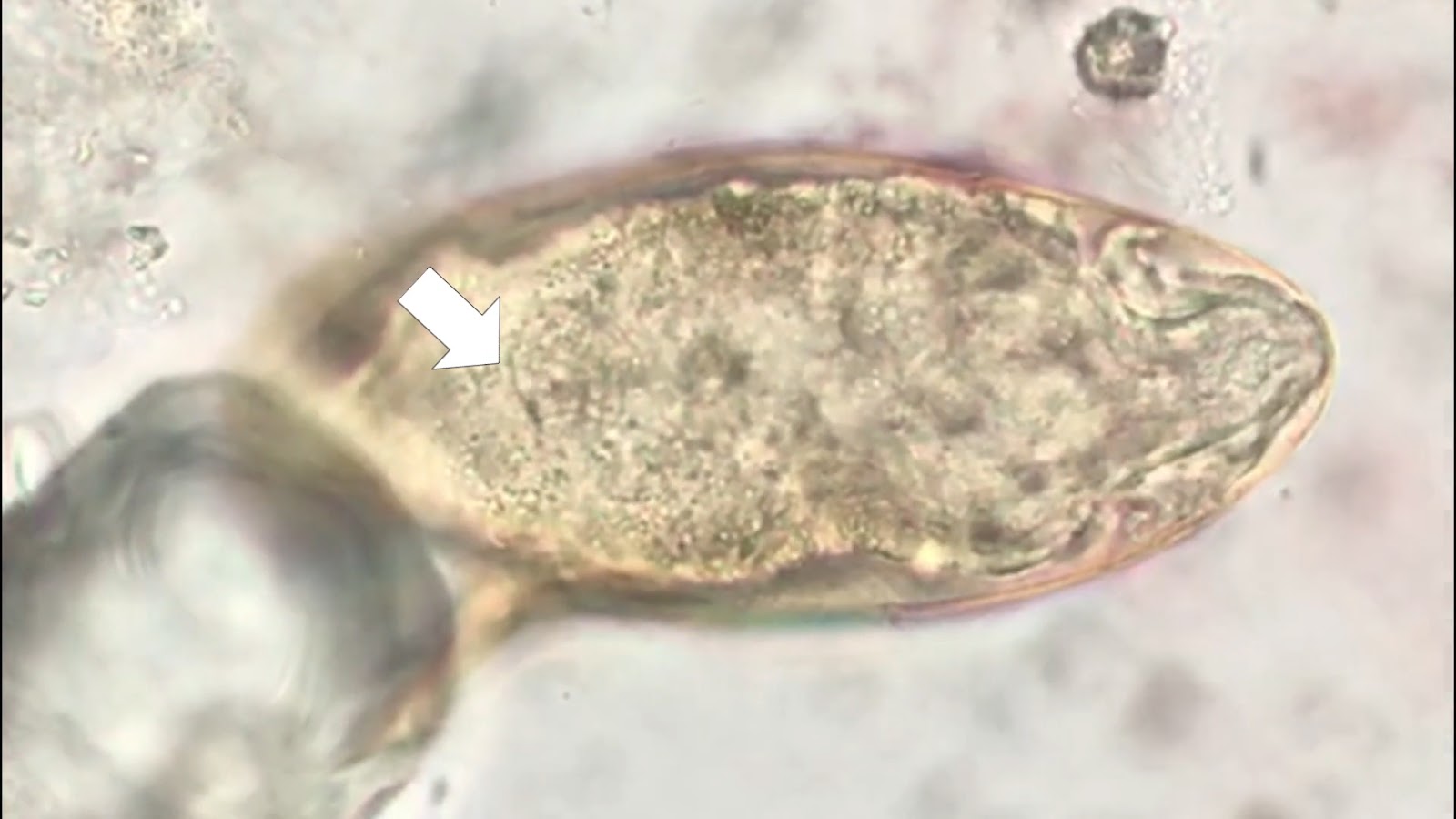Answer to the Parasite Case of the Week 769: Live Schistosoma mansoni ova. Note the motile miracidium with its characteristic 'flame cell' - a specialized cell that is part of its excretory system, characterized by a flickering, flame-like movement of cilia which helps to expel waste products from the egg (see image below, and be sure to check out the video HERE.
The following excellent discussion is written by our guest author, Dr. Azra Hasan:
Everyone rightly recognized the oval egg with a” lateral spine”, the hallmark feature of Schistosoma mansoni.
Sometimes, it may be necessary to tap the coverslip to move the eggs; the lateral spine may not be visible if the egg is turned on its side. In very light or chronic infections, eggs may be tough to detect in stool; therefore, multiple stool examinations may be required and a biopsy and/or immunologic tests for antigen or antibodies help diagnose infection in these patients.
Schistosomiasis (also known as bilharziasis) spreads when people come in contact with freshwater contaminated by microscopic swimming cercariae released from infected snails. These cercariae penetrate intact skin and mature into adult worms as shown in the life cycle below. Schistosoma mansoni is endemic in Africa, South America, and the Caribbean. Humans are the definitive host and snails (Biomphalaria spp.). are the intermediate hosts. Adult worms reside in blood vessels of the intestines, laying eggs that trigger inflammation, fibrosis, and organ damage.
Clinical features
- Acute:
- Cercarial dermatitis follows skin penetration by cercariae. Stronger reactions may be seen in previously-sensitized hosts.
- Katayama fever is characterized by fever, cough, malaise, and diarrhea (Acute hypersensitivity reaction to the migrating larvae of S. mansoni, also seen in S. japonicum and S. mekongi)
- Chronic:
- Eggs are deposited in the mesenteric venous system and enter the intestinal wall and liver where they trigger an eosinophilic granulomatous host response, resulting in bloody diarrhea.
- While some eggs are excreted in the stool, many remain trapped in the tissue.
- Over time, chronic inflammation leads to fibrotic changes in the liver, with rigid portal veins, and portal hypertension with hepatomegaly.
- Rarely, schistosomiasis may present as neuroschistosomiasis (seizures, paralysis) due to ectopic eggs (usually associated with S. japonicum).
Fun Facts:
- Schistosoma is an ancient foe. Schistosoma eggs were found in 3000-year-old Egyptian mummies!
- Clingy Couple: We have seen the female worm residing in the male’s gynecophoric canal. Did you know this is a lifelong “embrace”?
- Undercover agent: These parasites coat themselves in human proteins to hide from the immune system.
- Egg factory: A female S. mansoni will produce ~300 eggs per DAY
Treatment:
Praziquantel is the gold standard. Oxamniquine is effective only against S. mansoni. Resistance to both these drugs has been reported. Early treatment prevents portal hypertension and related complications
Prevention with improved sanitation and avoiding wading in insanitary water, is better than cure! (Praziquantel kills adult worms but not immature larvae- It is important to note that If treatment starts early, always follow up with retreatment).
Salmonella-schistosome syndrome: When a secondary bacterial infection (usually Salmonella) occurs, anti-schistosome and antibacterial therapy should be given together; the disease remains if the schistosome is not treated simultaneously.
Some interesting case reports:
- Ectopic Eggs: Hepatic granulomas mimicking cancer in a Brazilian man (DOI: 10.1016/j.ijid.2020.09.1436).
- Cardiac Schistosomiasis: A rare case of a 25-year-old man in Ethiopia with chest pain and heart failure was found to have S. mansoni eggs in myocardial tissue during autopsy. (PMID:32534906)
- Schistosoma Appendicitis- A case report of a 12-year-old Kenyan boy with acute appendicitis who had his appendix packed with S. mansoni eggs. (PMID 34840930)
- Pulmonary Hypertension- A 35-year-old Brazilian woman with chronic cough and fatigue had S. mansoni eggs in lung biopsies, leading to severe pulmonary hypertension DOI: 10.1183/13993003.congress-2019.PA5392
- The Traveler’s Nightmare- A German backpacker developed acute neuroschistosomiasis after swimming in the Nile. MRI showed spinal cord inflammation from ectopic eggs! (PMID:29232415)
- Rectal Prolapse in a Child: A 4-year-old Ethiopian girl with chronic rectal prolapse had S. mansoni eggs in rectal biopsies. Parasites weaken tissues over time! (PMID:31462942)
- Paste the PMID number in PubMed for full-text articles
- Type ‘Schistosoma’ in the search bar of this blog and walk through the pages for more images and reads.






No comments:
Post a Comment